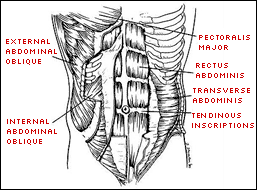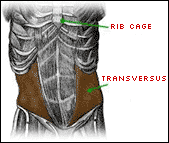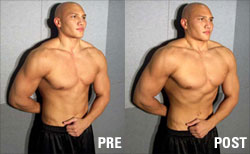— ARCHIVES —
Exercise of the Month - August 2006: Draw-Ins
Improve Core Function with “Draw-Ins”
“Drawing in” is a foreign term to many exercisers. An underrated movement, drawing in is in a nutshell- simply sucking in the belly. Analogous to pulling in the belly to squeeze into that perfect pair of jeans, draw-ins utilize the deep abdominal muscle known as the transverse abdominis, or transversus. Often the first muscle to fire during any movement, the transverse abdominis is a sheath of muscle that originates from the spine, wrapping around and attaching to the torso and pelvis. Habitually referred to as the body’s “natural weight belt,” the transverse abdominis may be a potential key for alleviating back pain (Boyle, M. Functional Training for Sports. Human Kinetics: 2004.)

To perform a draw in, the participant can essentially be in any comfortable position. For the purposes of this column, I will discuss standing draw-ins. I see far too many people in seated, sedentary-like positions for extended periods of time- whether in work or home-related settings. My preference is to have a client perform an exercise standing- if given the option versus alternative methods as this can activate an increased number of muscle fibers, particularly in the core region. Proper execution of a draw-in is as follows:

- Stand up facing forward with perfect posture (shoulder blades pulled back and down, head straight in line with the spine, torso, hips, knees, and ankles all facing straight ahead)
- Fasten a belt, rope, or any adjustable round item around the waist at a normal circumference.
- Without holding your breath, pull your belly button towards your spine and away from the belt, rope, etc…. This process is sometimes referred to as “vacuuming” or “hollowing” the abdominal contents.
- Perform 2-3 sets of 5 seconds and progress by increasing the duration of held contractions. A safe and effective 6-week progression is as follows:
- 1-3 sets of 5 second held contractions 2-3 days/week for Week 1
- 1-3 sets of 8 second held contractions 3 days/week for Weeks 2 & 3
- 2-3 sets of 10 second held contractions 3 days/week for Week 4
- 3 sets of 10-12 second held contractions 3 days/week for Week 5

Remember to breathe normally. It may seem like drawing in the abdomen correlates with holding one’s breath, but that is simply not true. Forcefully holding one’s breath may cause rapid increases in blood pressure. Make a conscious effort to keep the mid-section tight and secure throughout the movement. Participants with experience in engaging the deep abdominals in practices such as Pilates and Yoga may find draw-ins less difficult than those with little core strength and stability.

